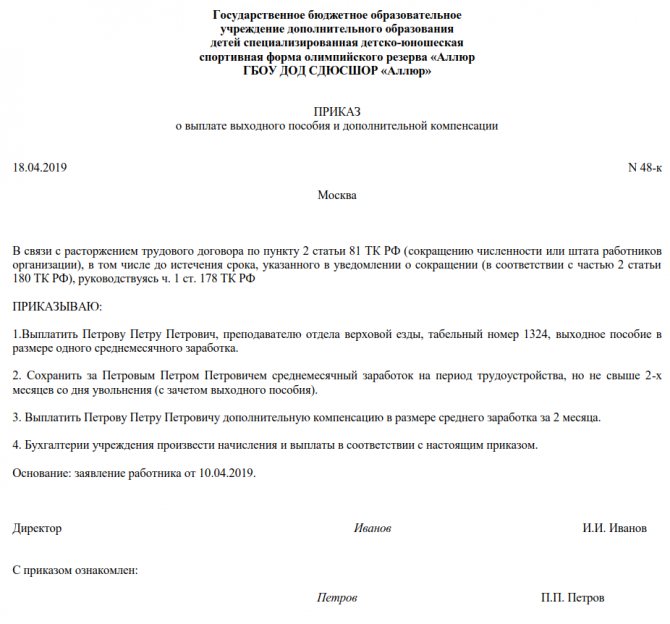Free legal consultation by phone:
8
Downsizing is the dismissal of employees due to a change in the structure of a company or organization. Most often, employers use this method of dismissing their employees if there are no special reasons to remove them from their positions early, but the company needs to reduce excess income and positions.
However, there are a number of laws when the director cannot remove from work certain employees who belong to a certain category of citizens or if the employee’s employment contract contains clauses that do not allow him to be dismissed without a good reason.
Reasons for reducing staff
The manager has the right to reduce the number of staff only if there are the following compelling arguments, which are provided for by the Labor Code of the Russian Federation in 2021:
- reorganization of the enterprise is expected;
- liquidation of the organization;
- Technical working conditions will be completely changed (automation and re-equipment of production).
As a rule, any reductions are associated with a reduction in costs due to upcoming structural changes, and a reduction in staff due to the presence of a large number of “unnecessary” specialists. In the second case, there is a redistribution of responsibilities and an increase in the workload per person.
In what cases is staff or headcount reduction carried out?
A reduction in the number or staff of employees is often associated with a review and change in the organizational and production structure of the company.
They, in turn, occur due to the redirection of activities, the appearance of new equipment at the enterprise, and the improvement of working conditions for workers in the company in accordance with the SOUT.
There are two concepts in this situation that are similar, but they must be distinguished by personnel officers - reduction in staff and reduction in their number.
Staff reduction entails deleting completely defined professions and positions from the staffing table. That is, the company will no longer have such workers at all. For example, the profession of a salesperson is excluded from the staffing table.
Sometimes management tries to justify such a reduction by dismissing an employee it does not like. One profession is removed from the staff, and another appears with the same functional responsibilities as the first, but with a different name. If this is discovered by the relevant authorities, then the company’s management cannot avoid problems, and penalties will also be applied to it.
The procedure for reducing the number of employees is associated with a reduction in staffing levels for a certain profession. The profession or position itself is retained in the staffing table.
This often happens when new equipment is introduced into the process, which is carried out during production automation. For example, the company employed four turners; after the commissioning of a new machine, the number of workers required to service it was only 2 people.
Attention! In any of these cases, the administration of the organization must understand that if it carries out dismissal to reduce staff or numbers, then there must be serious reasons for this. Otherwise, the court will restore the employee’s rights and return him to the company, while management will have to pay compensation and fines.
Notifying employees about layoffs
This notice is the most important document that is required to be drawn up when downsizing. Its correctness will be the starting point for a painless separation between the organization and employees, as well as for respecting the interests of both parties. In this case, any mistake made may become the basis for legal proceedings.

If a position is reduced, all employees who occupy it are fired. When the order is signed, a notification is sent to all employees. The document is signed by the employee and the date of signing is set.
In 2021, according to the Labor Code of the Russian Federation, notifications must be prepared and communicated to personnel two months before the approved date of dismissal (except for employees who make up certain categories of persons - seasonal workers and those working under fixed-term employment contracts).
The notice must contain the following information:
- name of company;
- date and registration number;
- title(notification);
- content part: for employees (list of proposed vacancies), trade union (list of positions to be eliminated), employment center (list of employees, positions they occupy and wages);
- manager's signature;
- the second copy for the dismissed person with his signature.
Employee payments
The employer is obliged to pay each employee compensation for dismissal due to staff reduction (2020). It includes:
- Wages for days worked.
- Compensation for missed vacation.
- Severance pay, the amount of which, as a general rule, is the average monthly salary (Article 178 of the Labor Code of the Russian Federation).
But there are exceptions and limitations:
- the amount of compensation may be higher if this is specified in the employment or collective agreement (part 4 of article 178 of the Labor Code of the Russian Federation);
- seasonal workers are paid their two-week salary (Part 3 of Article 296 of the Labor Code of the Russian Federation);
- those working under a fixed-term employment contract concluded for up to 2 months do not receive severance pay unless this is provided for in the contract (Part 3 of Article 292 of the Labor Code of the Russian Federation);
- religious organizations independently determine the amount of severance pay in contracts with their employees (part 2 of article 307, part 2 of article 347 of the Labor Code of the Russian Federation).
The amount of severance pay is determined according to the formula given in Decree of the Government of the Russian Federation dated December 24, 2007 No. 922:
The legislator has established another guarantee for employees - preservation of wages during the period of employment. In accordance with Article 178 of the Labor Code of the Russian Federation, a dismissed employee retains his average monthly earnings for a period not exceeding two months. Salaries can also be issued for the third month after dismissal, but to do this, the former employee must provide confirmation from the employment service that he applied to this body and was not employed. An even longer period for maintaining the average salary is established for those who work in the Far North and equivalent territories. It is 6 months after staff reduction (Article 318 of the Labor Code of the Russian Federation).

Drawing up an order for the dismissal of employees
There are two concepts - reduction of staff and numbers. The first involves the exclusion of a specific position from the HR, the second involves the dismissal of some employees performing identical job duties.
In the process of reducing specialists, the Administration of the enterprise is obliged to:
- draw up and sign the order;
- change SR;
- send a notice to the trade union with a list of positions that are planned to be removed from the ShR and a list of specific employees to be laid off.
If there is a reduction in staff, the Order must contain the following points:
- details: number, name, date of creation;
- a preamble indicating the specific reason for the reduction;
- the administrative part of the document contains a list of positions subject to reduction;
- the persons and responsibilities assigned to them for the execution of the order are listed;
- the responsible person is indicated;
- The order is signed by all employees mentioned in it.
Even if at least one point is missing, the order may be considered invalid and contrary to current legislation.
Payments due to staff reduction
When reducing staff numbers, the employer must be guided by current labor legislation. At the same time, it is not only reasonable and legal to part with employees, but also to accrue and pay them all the required compensation. Payments include:
- severance pay, which is assigned to an employee subject to dismissal, and is the average value of his monthly earnings. The benefit is maintained for two months if the person is unable to immediately find a new job;
- compensation for unused vacation. If an employee has vacation days left that he did not manage to use, they are also entitled to compensation upon dismissal. In this case, the payment is calculated regardless of the reason for termination of the employment relationship with the employer;
- wages for the time actually worked before dismissal. This payment makes up the majority of all benefits. It is from this that they start, making other accruals.
Taxation of payments
If an employer terminates an employment contract with an employee before the expiration of the notice period for dismissal, the additional compensation that is paid under Art. 180 of the Labor Code of the Russian Federation, is not income related to severance pay and average monthly earnings during the period of job search and is exempt from taxation in the part that does not exceed 3 times the average monthly salary (6 times for the Far North). This payment is not subject to personal income tax in full (clause 3 of article 217 of the Tax Code of the Russian Federation).
Based on clause 3 of Art. 217 of the Tax Code of the Russian Federation, Letter of the Ministry of Finance of the Russian Federation dated July 31, 2017 No. 03-04-07/48592, are subject to personal income tax in the part that is higher than 3 times the average monthly salary (6 times for the Far North), payments in the form of:
- compensation for unused vacation;
- severance pay;
- average monthly salary for the period of job search.
Who should not be laid off?
To avoid unpleasant consequences and administrative liability in the form of a fine, the employer must clearly understand that there is a category of people who cannot be fired. These include:
- pregnant women and employees who have children under three years of age;
- single mothers with a disabled child, if he is under 18 years of age;
- single mothers with a child under 14 years old;
- other persons raising such children.

In addition, you cannot fire an employee who is on vacation or sick leave.
All listed categories of persons can be reduced only:
- upon liquidation of an enterprise;
- by agreement of both parties.
There is also a category of employees who, when their numbers are reduced, have a lower risk of dismissal compared to other employees:
- showing high performance;
- have at least two dependents;
- are disabled by the Second World War, combat or labor;
- improve their qualifications in a specialty in which the employer is interested, without interrupting the performance of job duties.
Also, the enterprise may establish an additional list of persons, which will include employees with more than 20 years of experience in this organization, or those employees who have one year left before reaching retirement age.
The concept of reducing the number of employees of an organization or staff
In order for the enterprise’s operations to be effective, the employer makes personnel changes: fires or recruits employees, trains and retrains them. In business circles, the dismissal of company personnel at the suggestion of the employer without violations on the part of the employees is called layoff.
A reduction may concern headcount - the dismissal of one or more employees without structural changes in the company. Or state - when the CEO abolishes a position or an entire department and makes changes to the organizational structure.
The sales department employs 6 advertising sales managers. The employer decides to fire 3 people and reduce the number of employees by the number of people being laid off. If the manager decides to fire the entire sales department, we are talking about staff reduction - the exclusion of a functional unit from the organization's structure.
When an employer fires subordinates, he does not report to other employees, or to enterprises or the state. But his direct responsibility is to comply with all procedures established by law. First of all, notify employees in advance and submit information about the planned layoff to the local employment service 2 months before the actual dismissal (according to Part 2 of Article 25 of the Law of the Russian Federation of April 19, 1991 N 1032-1 “On Employment of the Population in the Russian Federation”). If he does not submit timely notice of the reduction of the company's personnel, then such dismissal may be considered invalid. And the fired person can easily appeal it in court.

Reduction of staff is the right of the employer, but it must be carried out according to the procedure established by law
Reasons for reduction
The Labor Code of the Russian Federation does not determine the reasons why the number or staff of an organization can be reduced. But they exist:
- economic - when the enterprise’s production or sales volume has decreased, its activities have ceased to be effective. Or stopped altogether. In this case, the problem of “extra” personnel arises, for whom there is simply no work. And there is nothing to pay them with - there is not enough budget;
- technological - when human labor is replaced by automated labor - a machine, program or other technological innovation;
- structural - when the enterprise management system changes, the previous departments of the company may become unnecessary.
The manager has the right to dismiss an entire department if this unit is no longer included in the company's structure. For example, the new CEO decides to fire all “sales people” due to downsizing. He must draw up an order to change the number of employees and the structure of the organization and “withdraw” the sales department from it.
Reduction without good reason is considered imaginary, that is, illegal. This happens when an employer wants to fire a specific person or group of people, but sees no other mechanism, so resorts to layoffs. If there is objectively no need for layoffs at the enterprise, the dismissed employee will be able to restore his rights through the court.
Who cannot be fired due to reduction
The law prohibits dismissal due to reduction:
- a pregnant woman;
- a woman who has at least one child under 3 years of age;
- a single mother or single father (who is raising a child until the age of 14; if the child is disabled, then until the age of 18);
- an employee under the age of 18 (permission from the guardianship authorities is required).

A pregnant woman cannot be fired due to reduction
You also cannot fire an employee who is:
- on sick leave at the time of layoff - this clause is regulated by clause 14 of Art. 81 Labor Code of the Russian Federation;
- on leave to care for a child under 3 years of age (clause 4 of Article 256 of the Labor Code of the Russian Federation);
- on any other leave - paid by the organization annually or at its own expense, including educational or administrative.
So, not everyone who works in an organization can be fired. If an employee is on vacation or sick leave, he will be able to sign a notice of layoff only after returning to work. It is more difficult to fire a woman who is on maternity leave - you will have to wait for her return. Even if this employee is already working, she still will not be laid off until the child turns 3 years old.
Preemptive right in case of reduction
Advantage over layoff is the priority right of one employee over others to remain at the same place of work.
The privilege to remain on staff is usually granted to employees with higher qualifications and/or labor productivity (Article 179 of the Labor Code of the Russian Federation).
For example, the company has a sales staff of 10 people. It is necessary to reduce it by 50% - fire 5 employees. In this case, the manager can bet:
- for education: leave workers with higher education and fire those who do not have it at all;
- for work experience: fire salespeople with less than 3 years of work experience (or any other period);
- on labor productivity: cut those who made fewer sales in the current month or season.
If the qualifications, education, or productivity of all employees on a staff are approximately the same, the right of preemption during layoffs works differently.
Remains in the same place:
- “family” - employees with 2 or more children aged 3 to 18 years;
- employees who fully provide for their family: his or her spouse does not officially work;
- those who received an industrial injury, illness or injury at their previous place;
- are undergoing vocational training or improving their qualifications at the expense of the company and without interruption from work;
- veterans and disabled people of the Great Patriotic War and other military actions about the defense of the Fatherland.
An exception that applies to absolutely all employees is the liquidation of an organization. Upon termination of activity, everyone is fired, regardless of the preferential right to remain.
Video: what employees need to know about layoffs
Rights and responsibilities of an employee
No company has the right to simply fire an employee. Even financial difficulties (temporary or permanent) are not an argument for reducing staff numbers. Based on the legal framework of the Russian Federation, all workers who have received layoff notices have the following rights:
- to receive severance pay equal to monthly earnings;
- to receive compensation for unused days of annual paid leave;
- to receive wages for the time actually worked in the last month;
- to receive compensation corresponding to the average wage at the enterprise, if the employee who was laid off was not offered a similar position, or he was unable to get a job after registering with the employment service.
Employee rights upon layoff

An employee always perceives a layoff from a negative perspective. However, he must know that no matter what, he has rights in this procedure.
The following can be distinguished:
- Before laying off employees, the administration of the company must send them written notice of future dismissal two months in advance. It can be given to the employee personally, and he must indicate with his visa that he received it, or by registered mail.
- Before dismissal, the dismissed person must be offered all available vacancies at the enterprise. This must also be done in writing.
- An employee working at the enterprise, after being laid off, can count on severance pay in the amount of average earnings for two months, and if he does not get a new job, then for the third month too.
- If an employee belongs to preferential categories of citizens who have the right to retain a place during layoffs, he can take advantage of it.
- Leave the enterprise ahead of schedule, without waiting for the deadlines for layoffs provided for by law to arrive.
Dismissal due to staff reduction: step-by-step instructions
The legislation provides for the protection of the interests of workers, therefore, when reducing staff, all employers are required to follow the instructions, according to which the following algorithm of actions is established:
- An order is issued and a new staffing table (SH) or a list of changes made to it is approved, where the following points must be indicated: the names of positions and the number of units identified for reduction; date of entry into force of the new SR; an order that each employee be given a notice against signature; the person responsible for the execution of this order is indicated.
- Notifications are sent to the employment center and trade union. The timing may vary: the general rule is two months; for individual entrepreneurs – two weeks; mass dismissal - three months in advance (based on Law No. 1032-1, paragraph 2, article 25).
- Employees who have a preferential right to avoid layoffs are determined (according to Part 1 of Article 179 of the Labor Code of the Russian Federation).
- Notifications are sent to employees subject to layoffs: each - two months before the expected date; for a fixed-term contract - three days in advance; seasonal workers - 7 days in advance.
- If an employee refuses to receive and sign a notification, a report is drawn up. The presence of witnesses during the procedure is mandatory.
- All workers who have been laid off are offered available vacancies. In this case, a position at a lower level and with a lower salary may be offered. If the employee does not agree, he writes a written refusal.
- A request is made to the trade union to obtain its opinion regarding a specific employee. The response from the union must be provided within seven days. If the trade union does not agree with the dismissal of an employee, it conducts a conversation with the employer, on the basis of which a protocol is drawn up.
- Termination of the employee’s employment contract with the employer is formalized in the form of orders.
- On the last day of work, those dismissed are given work books and compensation is paid.
If employees do not agree with the dismissal, they have the right to file a lawsuit against the employer within 30 calendar days after they receive the order and labor report. If, according to a court decision, the dismissal is unjustified and unfair, the employee is reinstated in his previous position and paid a monthly salary for forced absence.






